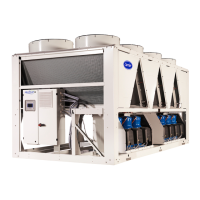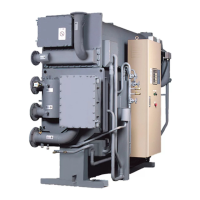Rigging 2-Piece Units— Two-piece units consist of all units
from 054-068 and, when specified, units 041-047. Refer to
the following procedure for rigging.
1. Absorber-evaporator assembly — Lift the absorber-
evaporator assembly from lift lugs at each end of ma-
chine. Refer to Fig. 1.
2. Generator-condenser assembly
a. Lift with cable slings placed under condenser water
boxes. Refer to Fig. 1.
b. Place generator-condenser assembly on top of absorber-
evaporator assembly.
c. Align the match marks stamped on one leg of each
generator-condenser and absorber-evaporator assem-
blies.
d. Make sure stamped serial numbers accompanying the
match marks correspond on both assemblies.
POSITION AND LEVEL THE EQUIPMENT — Isolation
pads are not necessary for most installations. However, for
cases where isolation pads are required, refer to Fig. 3 and
Table 3 for installation data.
It is not necessary to level the generator-condenser as-
sembly as both assemblies are designed to be level when the
absorber-evaporator assembly has been leveled.
The 16JB machine must be level within
1
⁄
4
in. per 20 ft,
both lengthwise and diagonally. To level the machine, pro-
ceed as follows:
1. Fill 50-ft length of clear flexible tubing completely with
water.
2. Use water gage and leveling reference points stamped on
absorber-evaporator shell to level machine. Leveling marks
on evaporator shell are covered by small removable one-
in. squares of insulation.
3. Level machine with shims until requirements are met. If
isolation assembly is used, shim under the soleplate.
ASSEMBLE 2-PIECE UNIT — Assemble 2-piece unit (see
procedure below). Then leak test and evacuate machine as
described in Leak Test and Machine Evacuation Procedures.
a. Bolt leg assemblies.
b. Weld the piping connections and make sure weld con-
nections are vacuum tight.
If chiller is assembled before it is rigged, do not lift ma-
chine under condenser water boxes to avoid damage to
machine. Machine should be lifted using lift lugs lo-
cated at each end of the machine.
Table 3 — Isolation Pad
and Soleplate Specifications
UNIT
16JB
NO. (EACH)
OF PADS AND
SOLEPLATES
DIMENSIONS
(in.)
DIMENSIONS
(mm)
Pad Soleplate Pad Soleplate
010
012
014
4 9 x 6.4 10 x 7.5 228 x 162 254 x 191
018
021
4 9 x 10.4 10 x 11.5 228 x 263 254 x 292
024
028
4 9 x 12.4 10 x 13.5 228 x 315 254 x 343
032
036
4 9 x 14.4 10 x 15.5 228 x 365 254 x 394
041
047
4 9 x 18.4 10 x 19.5 228 x 465 254 x 495
054
057
4 12 x 18.4 13 x 19.5 305 x 465 331 x 495
061
068
4 14 x 18.4 15 x 19.5 356 x 465 381 x 495
NOTE: Higher isolation efficiencies may be obtained with double-
layer pads. Double-layer pads, factory-fused together, are available
from various manufacturers. If 2 single-layer pads are used, a metal
divider equal to pad dimensions should be inserted between layers.
MACHINE LEAKTEST —All field-weld joints on the chiller
must be leak tested prior to starting the machine. Leak test
as follows:
1. Close all pump service valves, auxiliary evacuation valve
(Fig. 4) and purge exhaust valve (Fig. 5).
2. Refer to Table 4 for amount of refrigerant and nitrogen
required for leak testing.
3. If machine is under vacuum, bring to atmospheric pres-
sure with dry air or dry nitrogen.
4. Pressurize to 8 psig with Refrigerant 22. Charge through
auxiliary evacuation valve (item 9, Fig. 1).
5. Increase the machine pressure to 20 psig with dry air or
dry nitrogen.
Exceeding 20 psi will cause severe damage to chiller.
NOTES:
1. If optional shipping rails are on unit, be sure only the machine
base is on the isolation pad at each corner.
2. Shim under soleplate if necessary to level machine.
Fig. 3 — Typical Isolation Assembly
Fig. 4 — Auxiliary Evacuation Device
4

